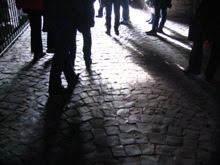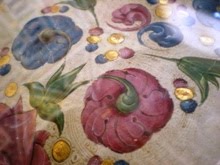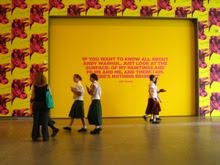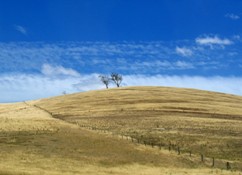still from Ocean Without a Shore Venica Biennale installation
image credit www.billviola.com
Midway thorough writing my thesis, before the self-imposed blog hiatus, I started composing a post about my trip to see the National Gallery of Victoria's installation of Bill Viola's Ocean Without a Shore. I didn't really know much about Viola beforehand, but the Age's writeup described the work as "epic, religious, devastating personal, poetic." This was something I needed to see for myself.
Ocean Without a Shore was first exhibited at the 2007 Venice Biennale, where it was installed inside the tiny fifteenth century church of San Gallo. The work explores the tentative threshold between dead and living, or as Viola himself puts it, "the presence of the dead in our lives." The installation consisted of three large video screens superimposed over the altars of San Gallo. Shadowy figures walk towards the viewer, becoming increasingly clear, until they break through a wall of water, imperceptible until the moment of contact. The violently cascading wall of water serves as a representation of the threshold between life and death: the intangible yet ever-powerful 'veil' separating the living from loved ones who have died. Once on the other side of the water wall, the figures appear in full colour, their gazes confronting and emotional. After a short time, each turns and passes back through the veil of water. The figure gradually fades to obscurity, and is replaced by another, approaching one of the other two screens.
The National Gallery of Australia's installation of Ocean Without a Shore uses a small, darkened room to evoke the intimacy of the work's initial showing. Even without the church setting, the overall effect is overwhelming and emotive. Viola reminds his viewers of the extent to which humans are obsessed with death by powerfully conveying the desire to 'see' loved ones who have died. Regardless of one's stance towards religion and the afterlife, the sense of loss as each figure disappears through the veil is palpable. All this, for video projections of strangers. Why? Because Ocean Without a Shore addresses our relationship with death as a universal experience. Death, and its implications, are something everyone must grapple with, and one person is as powerless as another to thwart it.
image credit: designboom
The National Gallery of Australia's installation of Ocean Without a Shore uses a small, darkened room to evoke the intimacy of the work's initial showing. Even without the church setting, the overall effect is overwhelming and emotive. Viola reminds his viewers of the extent to which humans are obsessed with death by powerfully conveying the desire to 'see' loved ones who have died. Regardless of one's stance towards religion and the afterlife, the sense of loss as each figure disappears through the veil is palpable. All this, for video projections of strangers. Why? Because Ocean Without a Shore addresses our relationship with death as a universal experience. Death, and its implications, are something everyone must grapple with, and one person is as powerless as another to thwart it.
image source: designboom
(last image is of the Venetian church, San Gallo)
I had the idea that Viola was using the universal human experience as a means to evoke an emotional response but it didn't really crystallise until I saw another of his works, The Raft. Based on Gericault's Raft of the Medusa, The Raft is a short film, which shows a group of strangers (seemingly waiting for a bus?). They stand together, but apart, each studiously avoiding contact with the others. This continues for some time, with slow motion capture used to highlight the minutiae of the group's gestures. Then, just as excruciatingly slowly, a giant wave of water begins to appear from the left of the frame, crashing over and inundating the crowd of people. They are washed - no, battered - by a solid wall of water for what seems like an eternity. Finally, the water recedes, leaving this once nonchalant crowd completely bowled over, clinging to each other for comfort and security. Here the universal theme that Viola is dealing with is suffering. more specifically the unifying effect of collective suffering.
image credit: University of California Humanities Research Institute
Suffering also comes up in yet another Viola piece that I saw recently, this time at the Australian Centre for Contemporary Art. Unspoken features the faces of a man and a woman, projected onto panels of beaten metal - silver and gold, respectively. Both faces show signs of intense grief and anguish, which, as in The Raft, is further emphasised by Viola's use of slow motion. The panels glow in the darkened room in a way reminiscent of religious icons, an analogy which is borne out by their powerful emotive, almost mystical effect.
[Edit: after a bit of further research into The Passions, the series of works which Unspoken belongs, it transpires that Viola was studying late Medieval devotional images at the Getty Research Institute in Los Angeles. This is also a good point to mention the wealth of information on Viola's work that can be found on both the National Gallery of Australia and the Getty Institute's websites, from a 2003 exhibition of The Passions. The Getty's site has clips from Viola's videos, and notes the connections between them and historical paintings, as well as providing excerpts from Viola's notebooks and explanations of his processes. Well worth a visit.]
With Unspoken, as with Ocean Without a Shore, I felt like I could spend hour upon hour simply staring at the work. As a general rule, I tend to dislike video art - I find most examples of the medium to be repetitive, smug, and detached to the point that they induce boredom. Viola's work is none of these things. It is immersive and direct, and above all, it is moving. This, for me, is the masterstroke. And given that this is quite possible my most text-heavy post yet, I'll leave it at that.
image credit: me!
miraculously managing not to shake
[Edit: after a bit of further research into The Passions, the series of works which Unspoken belongs, it transpires that Viola was studying late Medieval devotional images at the Getty Research Institute in Los Angeles. This is also a good point to mention the wealth of information on Viola's work that can be found on both the National Gallery of Australia and the Getty Institute's websites, from a 2003 exhibition of The Passions. The Getty's site has clips from Viola's videos, and notes the connections between them and historical paintings, as well as providing excerpts from Viola's notebooks and explanations of his processes. Well worth a visit.]
With Unspoken, as with Ocean Without a Shore, I felt like I could spend hour upon hour simply staring at the work. As a general rule, I tend to dislike video art - I find most examples of the medium to be repetitive, smug, and detached to the point that they induce boredom. Viola's work is none of these things. It is immersive and direct, and above all, it is moving. This, for me, is the masterstroke. And given that this is quite possible my most text-heavy post yet, I'll leave it at that.
+of+DSCN2645-pola.jpg)


































.jpg)














1 comment:
Great post, Amelia.
"Ocean Without a Shore addresses our relationship with death as a universal experience. Death, and its implications, are something everyone must grapple with, and one person is as powerless as another to thwart it."
At some stage, if your studies and/or interests lend you to it, have a look at Howard Barker's amazing meditation, "Death, the One and the Art of the Theatre". His thoughts on the omnipresence of death and the fundamental nature of tragedy in our art and lives are at once stunning and unsettling.
Post a Comment